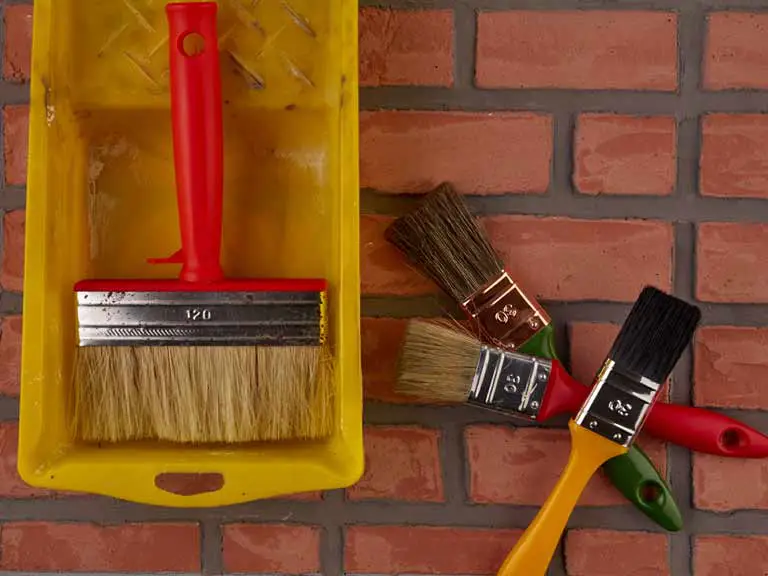
Painting with Limewash can seem intimidating, especially if you’re new to DIY projects. However, it can be a relatively straightforward process with the right preparation and techniques. Limewash is a mineral-based, eco-friendly paint that has been used for centuries to give walls a beautiful, textured finish. It’s popular for those looking to add character and charm to their homes.
One of the benefits of Limewash is that it’s a fairly easy and forgiving paint to work with. You need a good block brush and a mist sprayer. Then, limewash should be applied in very thin layers to a damp, porous surface free from contaminants. This makes it a great option for beginners who may not have as much experience with painting.
That being said, it’s important to note that Limewash requires more coats and more time curing between coats. Let’s take a closer look at what limewash is and the considerations you should make before attempting to use it.
What is Limewash?
Limewash is a type of paint used for centuries to create a beautiful, soft, matt finish on walls and other surfaces. It is made from a mixture of slaked lime (lime putty), water, and natural pigments and is often used on porous surfaces such as lime plasters, brick, stone, and stucco.
One of the main benefits of limewash is its breathability. This contrasts many modern paints, which can trap moisture and lead to mould and mildew growth. Limewash allows walls to breathe, preventing moisture from becoming trapped and causing damage. This makes it a great choice for use in damp or humid environments.
However, there are some downsides to using limewash. Because it is a porous material, it can be difficult to clean and maintain. This means it may not be as suitable for high-traffic areas or surfaces that are likely to get dirty or stained. Additionally, because it is a natural material, the colour may vary slightly from batch to batch, making it difficult to achieve a consistent look.
To get around this, always try to order all the limewash you will need in one go. This means it can be produced in one batch, and the colour should be more consistent.
Overall, if you are looking for a beautiful, natural finish that is breathable, mould-resistant, and has a unique texture and depth, limewash may be a great choice for your next painting project. However, it is important to carefully consider the pros and cons before deciding.
Related article: What is Limewash? An Overview of This Traditional Paint

Is Limewashing Easy or Difficult?
If you are considering limewashing your walls, you may wonder if it is easy or difficult. The good news is that applying limewash is relatively easy. All you need is a limewash block brush, a mist sprayer, maybe some sheeting and the right technique.
The key to successful limewashing is to apply the paint in thin layers. This will help you achieve even coverage. Limewash should appear almost see-through when initially applied. As it cures, it will gain depth of colour. You should also mix the paint thoroughly before starting to apply it to avoid streaks or blotches.
The aftercare is the difficult bit. Limewash cures slowly by absorbing carbon dioxide from the air. This is a slow process and can only take place while the limewash is still damp. For this reason, limewash MUST dry very slowly over 24 hours. If it’s drying too quickly, it should be lightly mist sprayed. Additionally, damp sheeting, like this hessian, can be hung in front of the limewash to help slow the drying.
When limewash dries too quickly, it will craze and crack. This will likely cause the surface to be dusty and powdery. Insufficient curing time will also cause the limewash to rub off on clothing.
In summary, applying limewash is relatively easy but requires some care and attention to achieve a professional-looking finish. The 24 hours after application are the most important and will determine the quality of the finish.
Related article: Limewash Pros and Cons: A Comprehensive Guide
Considerations to Make When Limewashing
When it comes to limewashing, there are a few important considerations to remember to ensure a successful outcome. Firstly, it’s important to note that limewash must cure slowly, taking around 24 hours to fully dry. During this time, extra care must be taken to ensure the limewash remains moist. This can be achieved by lightly mist-spraying the surface with water.
On hot days, it’s recommended to hang damp hessian sheeting in front of the limewash to prevent it from drying too quickly. This will help ensure the limewash cures evenly and doesn’t crack or peel.
It’s also important to note that limewash should only be applied to surfaces that are porous and able to absorb moisture. Non-porous surfaces such as metal or plastic should be avoided as the limewash will not adhere properly.
The surface you are painting must remain moist as the limewash is applied. A brush or, in some cases, a spray gun can be used to apply the limewash, depending on the size of the surface being painted.
Extra care should be taken during the 24-hour curing phase, as any disturbance to the surface can cause damage. It’s recommended to avoid touching or leaning against the surface during this time. If you damage the surface during this time, you can always apply an additional coat of limewash.
Finally, work in sections when limewashing. Do not stop halfway through a wall. Always complete the wall or ceiling you are painting. This helps to avoid any colour differences that could be caused by limewashing at different times of the day or in different conditions.
In summary, limewashing can be a beautiful and unique way to add texture and depth to your walls. However, it’s important to take the necessary considerations into account to ensure a successful outcome. By following the tips outlined above, you can achieve a stunning limewashed finish that will last for years to come.
Related article: What Surfaces Can Limewash be Used on? A Comprehensive Guide
Conclusion
In conclusion, painting with limewash can be a challenging task, but it is not impossible. It requires patience, attention to detail, and the right tools and materials. Here are some key takeaways to keep in mind:
- Limewash is a natural, eco-friendly paint made from lime and water. It is a great option for those who want to avoid VOCs and other harmful chemicals in their paint.
- Applying limewash requires a different technique than modern paint. You need to work in sections, apply multiple coats (usually at least 4), and use a brush or sprayer to achieve the desired texture and finish.
- It is important to prepare your surface properly before applying limewash. This includes cleaning, repairing, and dampening the surface to ensure good adhesion and prevent flaking and cracking.
Overall, painting with limewash can be a rewarding and satisfying experience, especially if you are looking for a natural, rustic look for your walls. You can achieve beautiful and long-lasting results with the right tools, materials, and techniques.

